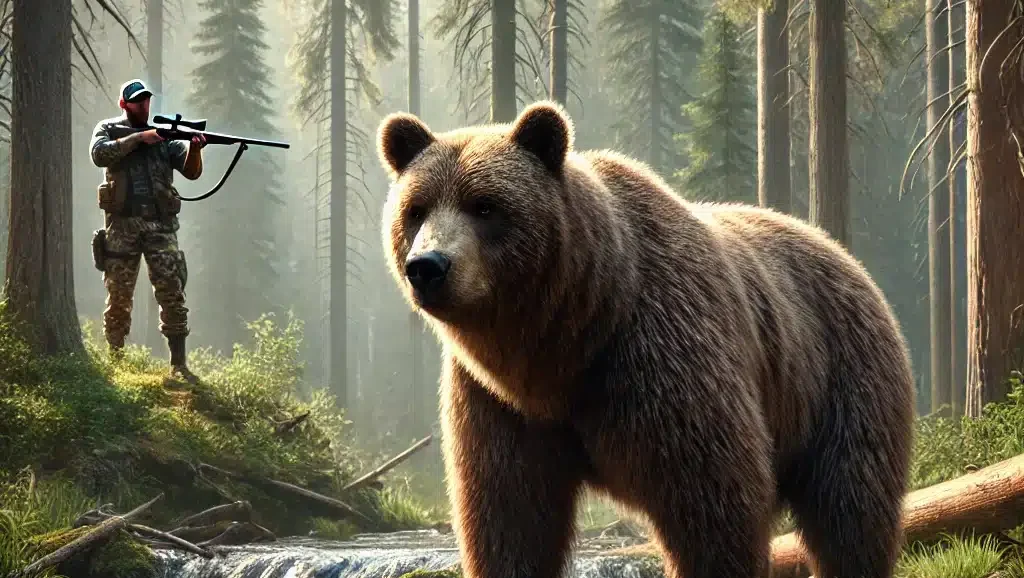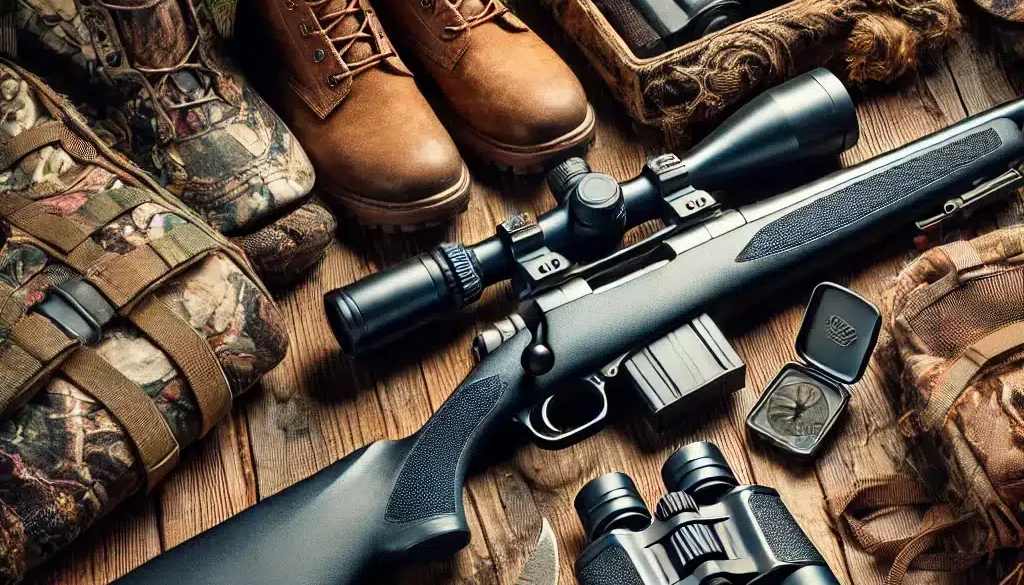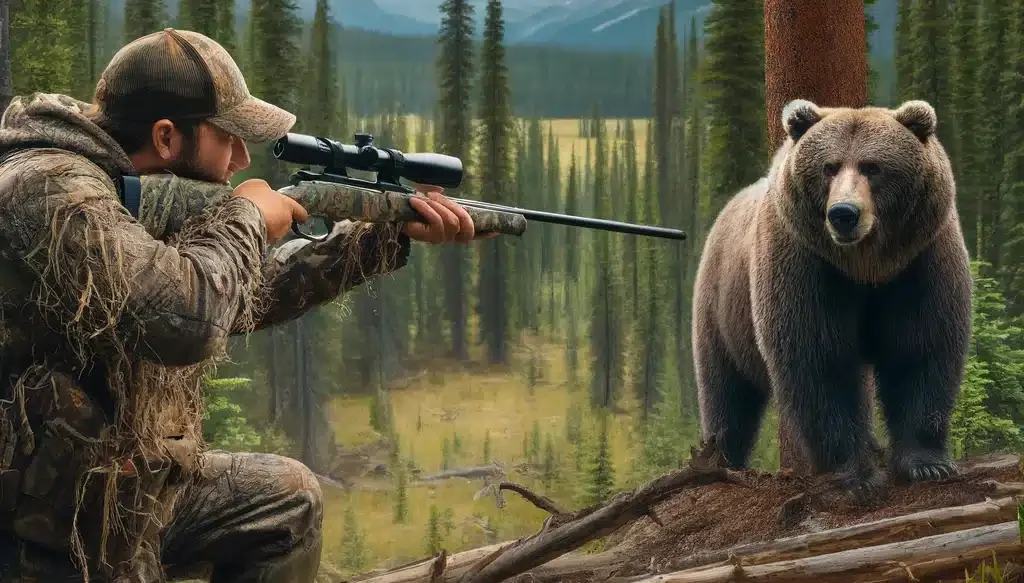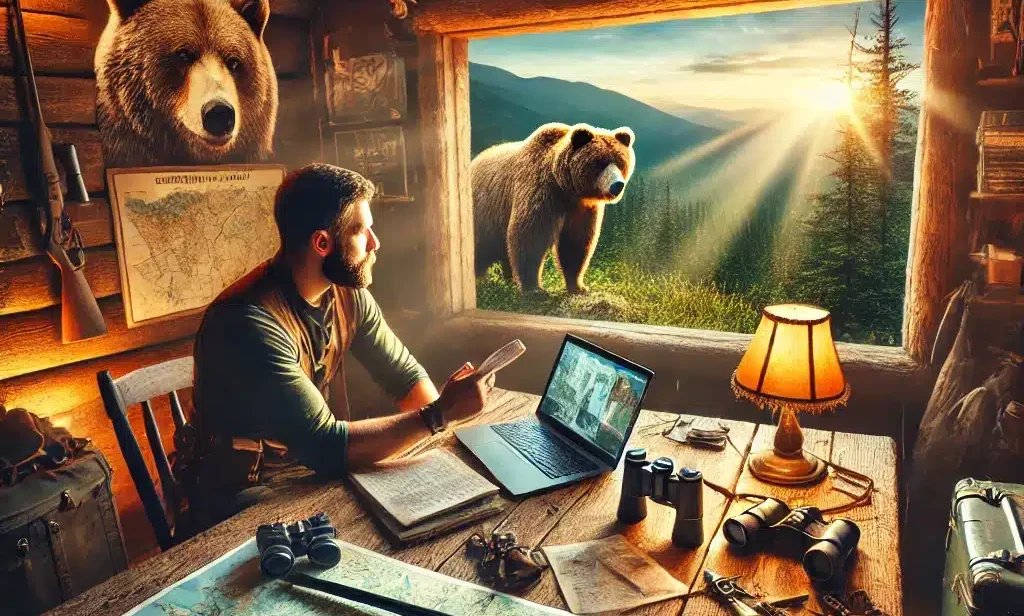Picture this: You’re deep in the wilderness, heart pounding, as you come face-to-face with one of nature’s most magnificent and fearsome creatures – the grizzly bear. Let’s hope you are ready to go grizzly bear hunting.

Have you ever dreamed of testing your skills against one of the most powerful predators in North America? Hunting the grizzly bear isn’t just a sport – it’s an adventure that will push you to your limits and leave you with stories to tell for a lifetime.
Getting to Know The Mighty Grizzly Bear
Before we dive into the nitty-gritty of hunting, let’s talk about the star of our show: the grizzly bear. These aren’t your average picnic basket-stealing cartoon bears – they’re real-life giants of the wilderness! Grizzly bears are typically solitary creatures, except for breeding pairs and females with cubs.
Where Can You Find Grizzly Bears? Grizzly Bear Hunting in Alaska
Grizzlies love to roam where the air is crisp, and the humans are few. You’ll find them hanging out in:
The rugged mountains of Alaska
The vast wilderness of western Canada
Parts of Wyoming, Montana, and Idaho in the lower 48 states
The Alaska grizzly bear hunt offers unique opportunities to experience these majestic creatures in their natural habitat, with specific hunting areas within established game management boundaries.
Think dense forests, alpine meadows, and salmon-rich rivers. That’s grizzly paradise!
What Makes a Grizzly a Grizzly?
Imagine a bear that looks like it’s been hitting the gym non-stop. That’s your grizzly! Here’s what sets them apart:
Size: They’re huge! Males can weigh up to 1,000 pounds – five average adult men!
Hump: Look for a distinctive hump between their shoulders. It’s all muscle, not fat!
Despite the name, grizzlies aren’t always grizzled gray. They can be blonde, brown, or even nearly black.
Claws: Their front claws are like curved daggers, sometimes as long as human fingers!
The arctic grizzly, a subspecies found in the Alaskan wilderness, is smaller with a thicker coat due to the harsh northern environment.
Grizzly Behavior 101 vs Brown Bears
Understanding how grizzlies act can make or break your hunt. Here’s the scoop:
They’re smart cookies. Grizzlies have excellent memories and problem-solving skills.
Their sense of smell is superhero-level. They can sniff out food from miles away!
Grizzlies are usually most active at dawn and dusk, but they can be on the move any time.
They’re not always grumpy, but they sure can be when surprised or if they feel threatened.
The Legal Lowdown
Before you get too excited, remember that hunting grizzlies isn’t a free-for-all. These magnificent beasts are protected in many areas. Here’s the deal:
Hunting is only allowed in specific regions and seasons.
You’ll need special permits and licenses, which can be tough.
A hunting license is crucial for grizzly bear hunting to comply with state regulations.
There are strict rules about how, when, and where you can hunt.
Always check the latest regulations in your area. Breaking the rules isn’t just illegal – it’s bad for conservation efforts and gives all hunters a bad name.
Remember, folks: hunting grizzlies is as much about respecting these incredible animals as it is about the thrill of the hunt. The more you understand them, the better and more responsible hunter you’ll be!
Gearing Up: Your Grizzly Hunting Shopping List

Alright, fellow adventurers, it’s time to talk about gear! When you’re going toe-to-toe (or, well, boot-to-paw) with a grizzly, you want to make sure you’re packing the right stuff.
Spike camps are also essential during grizzly bear hunting excursions, as these temporary, remote camps enhance the hunting experience by increasing accessibility to prime hunting areas.
The Big Gun Debate
First things first – you need a firearm that can handle a grizzly. This isn’t squirrel hunting, folks!
- Rifle or shotgun? Both can work, but most hunters prefer rifles for their accuracy at longer ranges.
- Caliber is key: Think big! .30-06 Springfield is often considered the minimum, but many experienced hunters go for even larger calibers like .300 Win Mag or .338 Win Mag.
- Whatever you choose, practice, practice, practice! A big gun doesn’t help if you can’t hit the broad side of a barn.
Eyes on the Prize: Optics
It would be best if you spotted that bear before it spots you. Here’s what you’ll want:
- Binoculars: Get a good pair that’s comfortable to use all day. 10×42 is a popular choice.
- Rangefinder: Because guessing distances in the wilderness is harder than it looks!
- Scope for your rifle: Make sure it’s rugged and can handle the recoil of your chosen firearm.
Dress for Success (and Survival)

Grizzly country isn’t known for its mild weather. Here’s what to wear:
- Layers, layers, layers! Think of a breathable base, warm insulating, and waterproof outer layers.
- Sturdy, waterproof boots: Your feet will thank you after miles of rocky terrain.
- Bright orange vest and hat: Safety first! You want other hunters to see you.
The “Just in Case” Kit
Hope for the best, prepare for the worst:
- First aid kit: Make it comprehensive. You’re a long way from the hospital out there.
- Bear spray: Yes, even when you’re hunting. It could save your life in a close encounter.
- Emergency shelter: A lightweight tent or a space blanket can be a lifesaver if you get stranded.
- Fire starting kit: Waterproof matches, a lighter, and some fire starters. Being cold and wet is no fun.
Extras That Make Life Easier
- Quality backpack: You’ll carry a lot of gear, so get one that fits well.
- Hunting knife: For field dressing your kill (if you’re successful).
- GPS device: Because getting lost in grizzly country is not on anyone’s bucket list.
- Camera: To capture the memories (and maybe some awesome bear photos if you’re lucky).
Remember, the best gear in the world won’t replace knowledge and experience. Take the time to learn how to use everything properly. And hey, if all this gear talk has your wallet sweating, don’t worry! You can often rent or borrow some of the pricier items when starting.
The most important piece of gear is your brain! Stay alert, make smart decisions, and prioritize safety over getting the “perfect shot.”


Hey There. I found your blog the usage of msn. This is a really well written article. I’ll make sure to bookmark it and return to read extra of your helpful info. Thanks for the post. I’ll definitely return.
Somebody essentially lend a hand to make significantly articles Id state That is the very first time I frequented your website page and up to now I surprised with the research you made to make this actual submit amazing Wonderful task